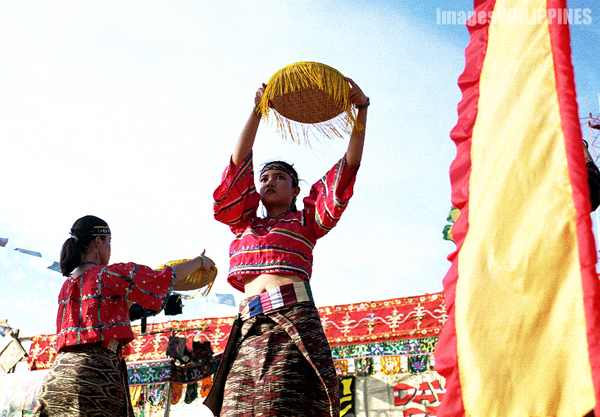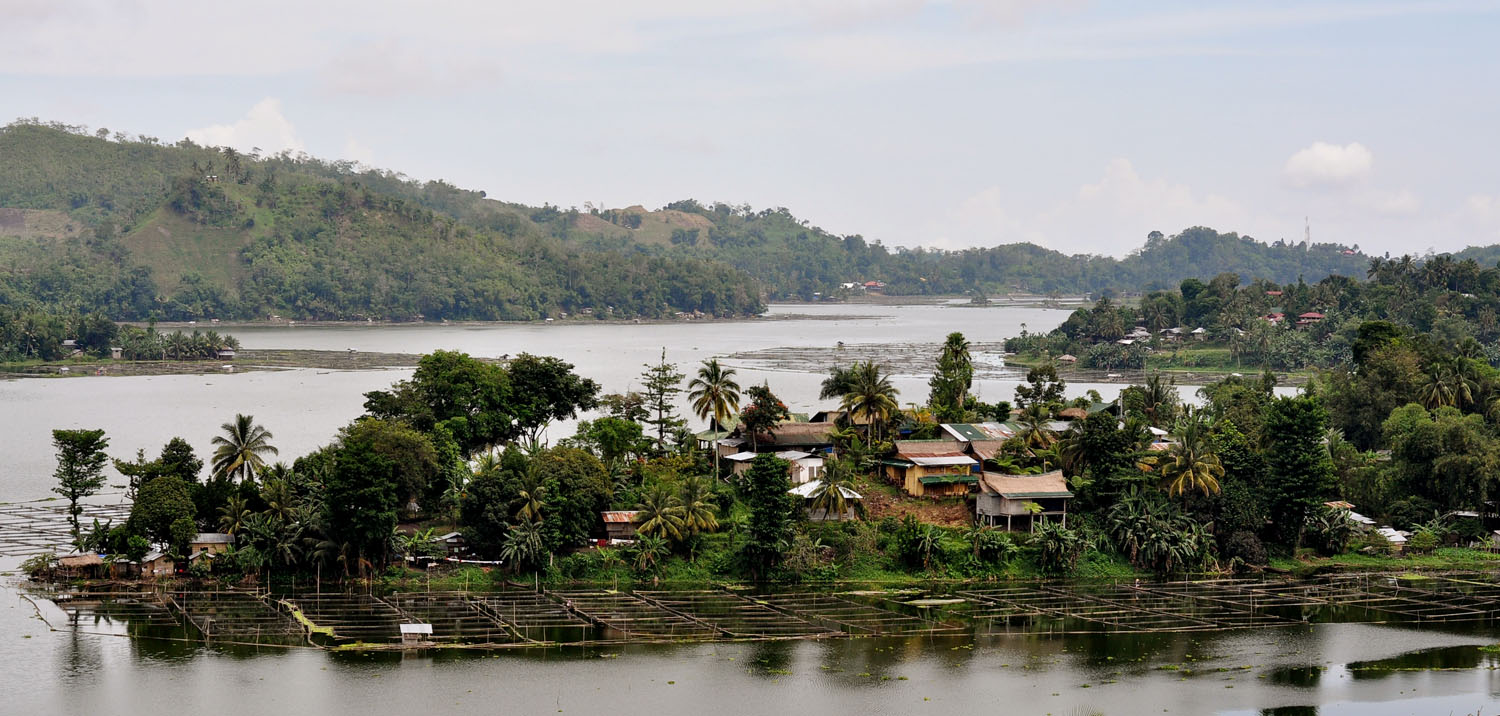The T’boli (Tagabili to lowlanders) are an animist ethnic group inhabiting highland areas in southwestern Mindanao, centering on Lake Sebu (TauSebu is another of the people’s names). Their immediate neighbors are the Manobo and Bilaan, other animist upland peoples (with whom they are often in conflict). The T’boli rely on Muslim traders for contacts with the lowlands and maritime trade.
In the T’boli origin myth, the god D’wata warns humans of a coming deluge. La Bebe, La Lomi, T’mefeles, and La Kagef hide inside a huge bamboo. After the waters recede, the four split their way out of the bamboo. La Bebe and La Lomi married, becoming the ancestors of the Christian Filipinos. La Kagef and T’mfeles also join and go on to produce 10 sons and daughters. Of these, Bou and Umen are the ancestors of the T’boli. The other 8 form couples; their descendants are the other non-Christian peoples of Mindanao, both Muslim and non-Muslim.
The T’boli culture is richly connected with, and inspired by nature; their dances mimic the action of animals such as monkeys and birds. The T’boli have a rich musical culture with a variety of instruments, but the T’boli music and songs are not meant for entertainment only. The Tribal songs are a living connection with their ancestors and also a source of ancient wisdom. The T’boli believe that everything has a spirit which must be respected for good fortune. Bad spirits might cause illness and misfortune, while the opposite is also true.

Tboli Deities
Kadaw La Sambad – The sun god and supreme god. Married to Bulon La Mogoaw, they reside in the seventh heaven. They begot seven sons and daughters who end up marrying each other.
Bulon La Mogoaw – The moon goddess and supreme goddess, wife of Kadaw La Sambad.
Cumucul – The eldest son who was given a cohort of fire, a tok (sword), shield, and the magical horse, Kaunting, who can be as small as a mouse when not ridden and who can be kept in a box (This reflects the honor given by the Tboli to eldest sons and the value they accord horses). Cumucul is married to Boi Kabil.
Sfedat – The second son who married his sister, the second daughter, Bong Libun. This marriage produced no progeny, leading to Sfedat’s despondency. One day, he asked his wife to kill him. His corpse became land from which sprouted all kinds of plants and trees.
Dwata – The third son who married two of his sisters, Sedek We and Hyu We. His request for one of the powers granted Cumucul is refused. Thus, he left the sky with his wives and seven children from Hyu We (Litik, Blanga, Teme Lus, Tdolok, Ginton, Lmugot Mangay, and Fun Bulol) and six from Sedek We. For a place to stay, he asked Bong Libun for the land that was once Sfedat’s body. Bong Libun agreed on the condition that she married one of his sons. Dwata spread the land, and planted the trees and other vegetation; the result is earth. The first people were created after Dwata breathed life into the clay figurines made by Hyu We and Sedek We. However Dwata did not fulfill his side of the bargain with Bong Libun, because his sons will not have her as wife.
Litik – The god of thunder.
Blanga – The god of stones and rocks.
Teme Lus – The god of wild beasts.
Tdolok – The god of death.
Ginton – The god of metallurgy.
Lmugot Mangay – The god of life and of all growing things.

Fun Bulol – The god of the mountains.
Bong Libun – Married to her brother Sfedat, however their marriage did not produce any progeny that lead to Sfedat’s despondency. Sfedat asked her to kill him, when she did as she was told, the corpse of Sfedat became land. Her other brother Dwata asked her for a piece of land that was once Sfedat’s body for a place to stay. She agreed on the condition that she married one of his sons. Dwata spread the land, and planted trees and other vegetation; the result is earth. The first people were created after Dwata breathed life into the clay figurines made by Hyu we and Sedek We. However, Dwata does not fulfill his side of the bargain with Bong Libun, because his sons will not have her as wife. She married her youngest brother Datu Bnoling. With him she had seven sons, who became scourges of the earth: Fun Knkel, Fun Daskulo, Fun Lkef, Fun Kumuga, Fun Blekes, and Fun Lalang.
Fun Knkel – The god of fever.
Fun Daskulo – The god of head diseases.
Fun Lkef – The god of colds.
Fun Kumuga – The god of eye afflictions.
Fun Blekes – The god of skin diseases.
Fun Lalang – The god of baldness.
Loos Klagan and La Fun – The divine couple; to alleviate the damage done by the scourges (the sons of Bong Libun and Datu Bnoling) they assumed the role of healers.
Muhen – A bird who is one of the most influential figures in the Tboli pantheon who is considered the god of fate, whose song when heard is thought to presage misfortune. Any undertaking is immediately abandoned or postponed when one hears the Muhen sing.

Story of the T’boli Deities
On the highest of the sky’s seven levels lived Kadaw La Sambad and Buyon La Mogoaw who begot 14 intermarrying children: Cumucul and Bo’i Kafil; S’fedat and Bong Libun; D’wata and Sedek We and Hyu We; Blotik and S’lel; Mule and B’lomi; Loos Klangan and La Fun; and bachelor Datu B’noling. Eldest Cumucul was entrusted the fire, sword and shield, and when D’wata asked for a share was refused and went to earth with Hyu We who afterwards begot L’tik, B’langa, Temo Lus, T’dolok, Ginton, M’ngay and Fun Bulol, and Sedek We who begot Kayung, Slew, S’mbleng, Nagwaang, Nga Hule and S’ntan.
Having no children, S’fedat asked Bong Libun to kill him and his body became the land with all its vegetation, which Bong Libun promised to D’wata as a place for alighting on condition that she marry one of his sons.
D’wata with his sons’ help built the house on posts while fashioning people from soil mounds were his wives Hyu We and clumsy Sedek We had the noses inverted and the genitals on the knees, later corrected when Hyu We slapped Sedek We’s figures in exasperation for her foolishness. In their argument Sedek We hit the sky in pounding rice, which angered the latter and decided to go further up. In placing the clay figures Hyu We wanted them on the moon so they would remain as children but Sedek We favored the stones to harden their bodies and while Hyu We was away she placed them on a banana plant, which explained their fertility (like banana) and mortality (from S’fedat’s body, the earth), while D’wata blew life on them.
Fleeing from his aunt-bride Bong Libun, L’mugot M’ngay was searched in turns by D’wata’s sons T’dolok, who left his bows, arrows and dog to become the god of death; B’langa, the god of stones; Teme Lus who became god of wild beasts; Ginton (maker of singkil brass anklets, blonso brass bracelets, hilot chain-mail girdles and t’sing ring) who settled on Hulon volcano to work on his metals; Fun Bulol the god of mountains; and L’tik the god of thunder. Abandoned by his sons, D’wata returned to the sky.
SOURCES:
Eugenio, Damiana L. (2001), Philippine Folk Literature: The Myths, UP Press
Casal, Gabriel S. (1978), T’Boli Art in Its Socio-Cultural Context, Ayala Museum
Jordan Clark is a Canadian born descendant of Scottish immigrants living on the homelands of the Lekwungen speaking peoples. His interest in Philippine myth and folklore began in 2004. Finding it difficult to track down resources on the topic, he founded The Aswang Project in 2006. Shortly after, he embarked on a 5 year journey, along with producing partner Cheryl Anne del Rosario, to make the 2011 feature length documentary THE ASWANG PHENOMENON – an exploration of the aswang myth and its effects on Philippine society. In 2015 he directed “The Creatures of Philippine Mythology” web-series, which features 3 folkloric beings from the Philippines – the TIKBALANG, KAPRE and BAKUNAWA. Episodes are available to watch on YouTube. Jordan recently oversaw the editing for the English language release of Ferdinand Blumentritt’s DICCIONARIO MITOLÓGICO DE FILIPINAS (Dictionary of Philippine Mythology) and is working on two more releases with fellow creators scheduled for release later this year. When his nose isn’t in a book, he spends time with his amazing Filipina wife of 20 years and their smart and wonderful teenaged daughter.


